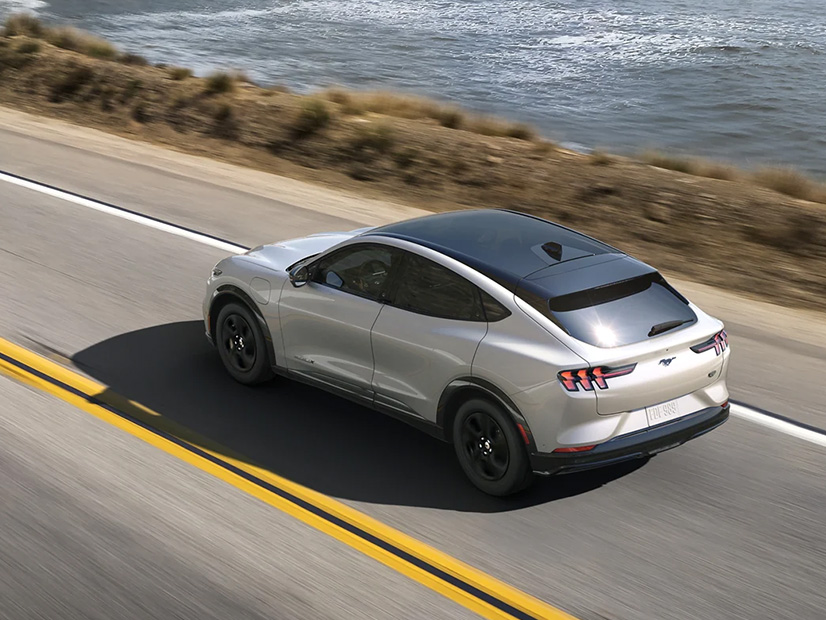
Figuring out whether a new electric vehicle qualifies for one of the Inflation Reduction Act’s $7,500 tax credits got a little easier on Friday as the U.S. Treasury Department updated its guidelines to base vehicle classifications on the model information listed on the car’s price sticker.
Under the IRA, EVs classified as SUVs or pickup trucks are only eligible for the tax credit if their manufacturer’s suggested retail price is $80,000 or less. The MSRP cap for sedans and other passenger vehicles is $55,000.
In its previous guidelines, released at the end of 2022, Treasury had based these classifications on EPA’s Corporate Average Fuel Economy (CAFE) standard, which sets fleetwide averages for fuel efficiency. The information on vehicle price stickers is based on EPA’s Fuel Economy Labeling standard, which is calculated from a model’s fuel savings over a five-year period.
In some cases, the vehicle classification based on the CAFE standard was different from the classification on the automaker’s price sticker ― also available on EPA’s fueleconomy.gov website ― causing confusion and uncertainty for both consumers and auto dealers.
For example, Treasury initially classified the Ford Mustang Mach-E SUV as a sedan, limiting the availability of tax credits to consumers buying a model with an MSRP $55,000 or less. Under this classification, only two of the Mach-E’s four 2023 models, the Select and Premium, would have qualified for the tax credit.
The update reclassifies the car as an SUV, putting all four of its 2023 models ― top price, $63,995 ― well below the $80,000 MSRP price cap for SUVs.
Chris Smith, Ford’s chief government affairs officer, welcomed the update. “We recognize that the Treasury Department has a huge task in front of them in implementing the Inflation Reduction Act. We sincerely appreciate their consideration and hard work to make sure that more customers are able to access clean vehicle tax credits under the [IRA],” he said.
General Motors and Tesla faced similar limits on some of their models, specifically GM’s Cadillac Lyriq SUV and Tesla’s Model Y.
GM lobbied the department for changes, as reported by The Street. The automaker argued that “in determining how vehicles should be classified, Treasury should leverage existing U.S. government definitions and practices. … This drives consistency across existing federal policy and clarity for consumers.”
A statement from the automaker on Friday noted that the change “will allow crossover vehicles that share similar features to be treated consistently,” according to The Street.
Tesla had already cut prices on its Model Y in January, The Verge reported. But the company raised prices on both Model Y configurations ― the Long Range and Performance ― hours after Treasury issued its update.
Domestic Content Delay
The updated guidelines on vehicle classification clears up some of the confusion about the EV tax credits. But Treasury’s delay in issuing critical guidelines for the IRA’s domestic content requirements remains a point of ongoing controversy.
The law required Treasury to issue these guidelines by Dec. 31, 2022; however, Friday’s announcement reiterated the department’s plan to release them in March. (See Treasury Delays Key Rules for IRA’s EV Tax Credits.)
As originally written in the IRA, to qualify for the full $7,500 tax credit, an EV’s battery must contain a certain percentage of critical minerals sourced in North America or from a country with which the U.S. has a free-trade agreement. A certain percentage of other battery components must also be sourced in North America.
The domestic content requirements start this year at 40% for critical minerals and 50% for battery components, ramping up in subsequent years.
If one of the domestic content requirements is not met, a consumer may only get half the credit. While delaying the guidelines on domestic content, Treasury is allowing EV buyers to claim the full $7,500 credit.
European automakers and government officials have widely criticized the requirements, labeling them as protectionist and likely to cause a “subsidy war.”
Speaking at the Washington Auto Show last month in D.C., EU Ambassador Stavros Lambrinidis warned that with both the union and U.S. putting billions into transportation decarbonization, “the biggest mistake that governments can do is to get into a subsidy war.”
“That’s a danger because the IRA, the way it’s structured, in a sense is endangering investment in Europe. It is sucking away investment potential, especially at a time of very high energy prices,” he said. “Nothing could be worse for the strength of the U.S. economy and U.S. companies than a weak European economy.” (See Tracking the Contradictions of the US EV Market at the DC Auto Show.)
Sen. Joe Manchin (D-W.Va.) has also criticized the delay, introducing a bill that would require the department to implement the guidelines immediately and make them retroactive to Jan. 1. As chair of the Senate Energy and Natural Resources Committee, Manchin has consistently argued that the IRA’s domestic content requirements are aimed at building out a domestic supply chain and cutting U.S. dependence on China for critical mineral processing and battery component manufacturing.
“We’re moving rapidly into the EV markets — and I think, recklessly — as we were going into that before we were able to supply [domestic production] and be held captive by China,” he said during a Senate floor debate on Jan. 26. (See IRA’s EV Tax Credits Spark Senate Debate.)
The bill has yet to receive a committee hearing or a vote in the Senate.



